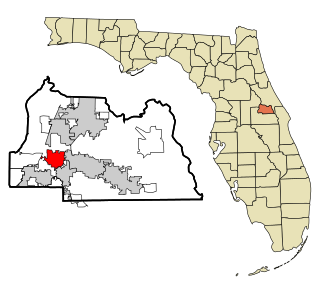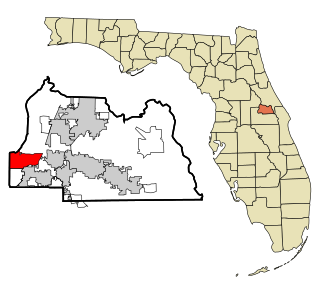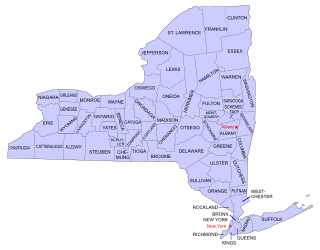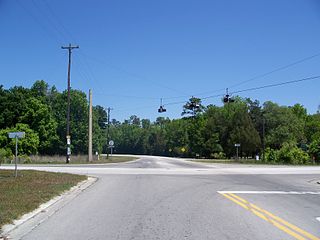
Seminole County is a county located in the central portion of the U.S. state of Florida. As of the 2020 census, the population was 470,856, making it the 13th-most populated county in Florida. Its county seat and largest city is Sanford. Seminole County is part of the Orlando-Kissimmee-Sanford, Florida Metropolitan Statistical Area.

Apopka is a city in Orange County, Florida. The city's population was 55,000 at the 2020 census. It is part of the Orlando–Kissimmee–Sanford Metropolitan Statistical Area. Apopka comes from Seminole word Ahapopka for "Potato eating place".

Longwood is a city in Seminole County, Florida, United States. The population was 15,087 at the 2020 census. It is part of the Orlando–Kissimmee–Sanford, Florida Metropolitan Statistical Area.

Wekiwa Springs is a census-designated place and an unincorporated area in Seminole County, Florida, United States. The population was 23,169 at the 2000 census. It is part of the Orlando–Kissimmee–Sanford, Florida Metropolitan Statistical Area.
State Road 429 (SR 429), also known as the Daniel Webster Western Beltway or Western Expressway south of US 441, and the Wekiva Parkway north of US 441, is a controlled-access toll road built and maintained by the Central Florida Expressway Authority (CFX), the Florida's Turnpike Enterprise, and the Florida Department of Transportation (FDOT). Its mainline currently extends 51.77 miles (83.32 km) from I-4 (SR 400) in Four Corners north to I-4 in Sanford. Control cities are Apopka and Tampa although the control cities for traffic at the entrances at US 441 and north are Orlando, Tampa, and Daytona Beach. SR 429 was originally planned as a western half of SR 417.

Buildings, sites, districts, and objects in New York listed on the National Register of Historic Places:

Lower Wekiva River Preserve State Park is an 18,000-acre (7,300 ha) Florida State Park located on six miles (10 km) of the St. Johns River in Lake and Seminole counties. The park forms a wildlife corridor to the Ocala National Forest along the Wekiva and St. Johns Rivers.
Rock Springs Run State Reserve is a 14,000-acre (5,700 ha) State Park in the U.S. state of Florida. The main entrance is located about 30 miles (48 km) north of Orlando in Sorrento, 3 miles (4.8 km) west of the Wekiva River bridge on State Road 46 and extends into Orange and Seminole Counties to the south. The park contains a number of Indian mounds, pine flatwoods, swamps and artesian springs, and a number of creeks and rivers. Among them are Seminole Creek, Wekiwa Springs Run, Rock Springs Run, and the Wekiva River.

Wekiwa Springs State Park is a 7,000-acre (28 km2) Florida State Park in Apopka, Florida. It is located 20 minutes north of Orlando, off Interstate 4 at exit 94, near Altamonte Springs and Longwood. The park also contains the head water of the Wekiva River. It also serves as the headquarters of one of the state's five AmeriCorps Florida State Parks chapters.
These historic properties and districts in the state of Texas are listed in the National Register of Historic Places. Properties and/or districts are listed in most of Texas's 254 counties.

The River Road Historic District is a U.S. historic district located in Orange Park, Florida. The district is at the junction of River Road and Stiles Avenue. It contains ten historic buildings.

The Wekiva River is a 16.0-mile-long (25.7 km) river in Central Florida, north of Orlando in the United States. It originates in Apopka and joins the St. Johns River, the longest river in the state, in DeBary. The Wekiva River system includes the main stem joined by three main tributaries - Rock Springs Run, Blackwater Creek, and the Little Wekiva River - and about 30 contributing groundwater springs. It is designated as a Florida State Canoe Trail, an Outstanding Florida Water, and an Aquatic Preserve by the Florida Department of Environmental Protection. The Wekiva River system is also one of the two rivers in Florida federally designated as a National Wild and Scenic River for its scenery, recreation, geology, and diverse habitats.

This is a list of the National Register of Historic Places listings in Orange County, Florida.
Wekiva High School is a high school located in Apopka, Florida, United States. The school mascot is the mustang. The school colors are maroon, navy and gold. It was established in 2007 as a relief school for Apopka High School and Ocoee High School. Its principal since July 2023 is Kenisha Williams.

This is a list of the National Register of Historic Places listings in Indian River County, Florida.
The following is an alphabetical list of articles related to the U.S. state of Florida.

Gulf Hammock is an unincorporated community in Levy County, Florida, United States. It is near the edge of, and named for, the large wetlands area known as Gulf Hammock. It is located where US 19-98 and County Road 326 cross, near the Wekiva River, approximately 6 miles (9.7 km) southeast of Otter Creek.
The Wekiva River, also known as Wekiva Creek or Wekiva Run, is a tributary of the Waccasassa River in Levy County, Florida that originates at Wekiva Spring. From the spring the river meanders westward and then southward about 7 miles (11 km) to where it flows into the Waccasassa River. It is fed along the way by Mule Creek and the Little Wekiva River. The river is centrally located in the area between the Withlacoochee and Suwannee Rivers that is often referred to as the Gulf Hammock.















